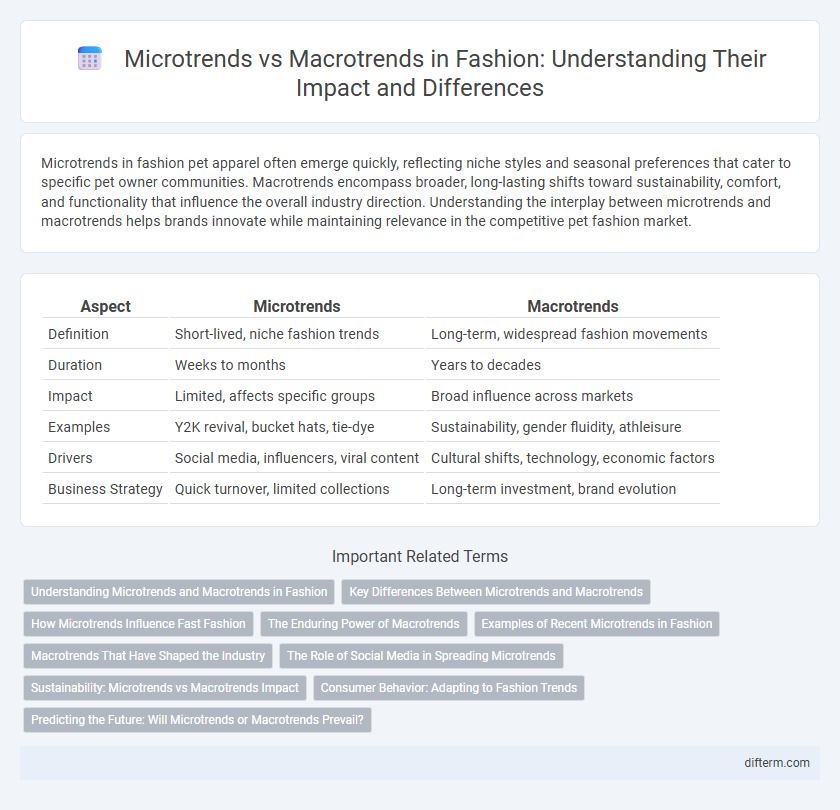Microtrends in fashion pet apparel often emerge quickly, reflecting niche styles and seasonal preferences that cater to specific pet owner communities. Macrotrends encompass broader, long-lasting shifts toward sustainability, comfort, and functionality that influence the overall industry direction. Understanding the interplay between microtrends and macrotrends helps brands innovate while maintaining relevance in the competitive pet fashion market.
Table of Comparison
| Aspect | Microtrends | Macrotrends |
|---|---|---|
| Definition | Short-lived, niche fashion trends | Long-term, widespread fashion movements |
| Duration | Weeks to months | Years to decades |
| Impact | Limited, affects specific groups | Broad influence across markets |
| Examples | Y2K revival, bucket hats, tie-dye | Sustainability, gender fluidity, athleisure |
| Drivers | Social media, influencers, viral content | Cultural shifts, technology, economic factors |
| Business Strategy | Quick turnover, limited collections | Long-term investment, brand evolution |
Understanding Microtrends and Macrotrends in Fashion
Microtrends in fashion represent short-lived, niche styles that rapidly gain popularity on social media platforms, influencing consumer behavior within weeks or months. Macrotrends encompass long-term shifts in cultural attitudes, technology, and lifestyle that shape the industry over years or decades, such as sustainability or gender-neutral fashion. Recognizing the interplay between microtrends and macrotrends enables brands to innovate effectively while maintaining relevance in an evolving market.
Key Differences Between Microtrends and Macrotrends
Microtrends in fashion are short-lived, highly specific styles that emerge from niche groups and often fade within a season or year, driven by social media and youth culture. Macrotrends represent long-term, widespread shifts influencing the industry over several years, such as sustainability or gender fluidity, shaping broader design, production, and retail strategies. Understanding these key differences helps fashion brands tailor marketing efforts and product development to either capitalize quickly on microtrends or build lasting relevance around macrotrends.
How Microtrends Influence Fast Fashion
Microtrends drive fast fashion by rapidly introducing niche styles that capture immediate consumer interest, leading to quick design cycles and frequent product turnover. These short-lived trends allow brands to experiment with bold aesthetics and cater to diverse tastes without long-term commitment. Fast fashion's agility in adopting microtrends accelerates market responsiveness and boosts sales through constant novelty.
The Enduring Power of Macrotrends
Macrotrends shape the fashion industry by influencing consumer behavior and driving long-term market growth, often spanning decades. Their enduring power lies in the deep cultural and societal shifts they represent, such as sustainability, gender fluidity, and digital innovation. Unlike microtrends that fade quickly, macrotrends create stable frameworks for brands to develop lasting collections and meaningful brand identities.
Examples of Recent Microtrends in Fashion
Recent fashion microtrends include Y2K-inspired low-rise jeans, micro bags, and vibrant neon colors, rapidly gaining popularity among Gen Z consumers on social media platforms like TikTok. These microtrends often last only a few months, contrasting with sustainable macrotrends such as minimalism and gender-neutral clothing that shape the industry over several years. Brands leverage microtrends to stimulate quick sales cycles, while macrotrends influence long-term product development and market positioning.
Macrotrends That Have Shaped the Industry
Macrotrends such as sustainability, digital transformation, and gender fluidity have significantly reshaped the fashion industry by driving widespread adoption of eco-friendly materials, innovative technology integration, and inclusive design practices. These large-scale shifts influence consumer behavior, supply chain strategies, and brand identities on a global level. Unlike microtrends, which are short-lived and niche, macrotrends establish enduring patterns that redefine industry standards and market demands.
The Role of Social Media in Spreading Microtrends
Social media platforms like Instagram, TikTok, and Pinterest accelerate the spread of microtrends by enabling real-time sharing and viral content creation among fashion enthusiasts and influencers. The algorithm-driven exposure amplifies niche styles rapidly, allowing microtrends to gain widespread attention within days or weeks. This dynamic contrasts with macrotrends' slower adoption cycles, as social media democratizes trendsetting and shortens fashion life spans.
Sustainability: Microtrends vs Macrotrends Impact
Sustainability as a macrotrend drives long-term industry shifts towards eco-friendly materials and circular fashion models, influencing global supply chains and consumer behavior. Microtrends in sustainability often spotlight specific initiatives like vegan leather or zero-waste packaging, creating short-term spikes in consumer interest. The lasting impact in fashion sustainability arises from macrotrend adoption, while microtrends serve as experimental grounds for niche innovations.
Consumer Behavior: Adapting to Fashion Trends
Consumer behavior in fashion shows a dynamic shift between microtrends and macrotrends, with buyers rapidly embracing microtrends for instant gratification and novelty. Macrotrends, rooted in cultural shifts and sustainability, influence long-term purchasing decisions and brand loyalty. Shoppers weigh the desire for quick style updates against the value of enduring, ethically driven fashion investments.
Predicting the Future: Will Microtrends or Macrotrends Prevail?
Microtrends rapidly capture niche consumer interests with distinct styles, often influencing social media and streetwear but typically fading within months. Macrotrends, driven by deep cultural shifts like sustainability and gender-fluid fashion, shape industry-wide changes with lasting impact over years or decades. Predicting fashion's future entails balancing the immediate buzz of microtrends against the enduring transformation commanded by macrotrends, where data on consumer behavior, environmental concerns, and technological advancements increasingly favor macrotrend dominance.
microtrends vs macrotrends Infographic

 difterm.com
difterm.com